The Samsung 850 EVO 4TB SSD Review
by Billy Tallis on July 11, 2016 10:00 AM ESTMixed Random Read/Write Performance
The mixed random I/O benchmark starts with a pure read test and gradually increases the proportion of writes, finishing with pure writes. The queue depth is 3 for the entire test and each subtest lasts for 3 minutes, for a total test duration of 18 minutes. As with the pure random write test, this test is restricted to a 16GB span of the drive, which is empty save for the 16GB test file.
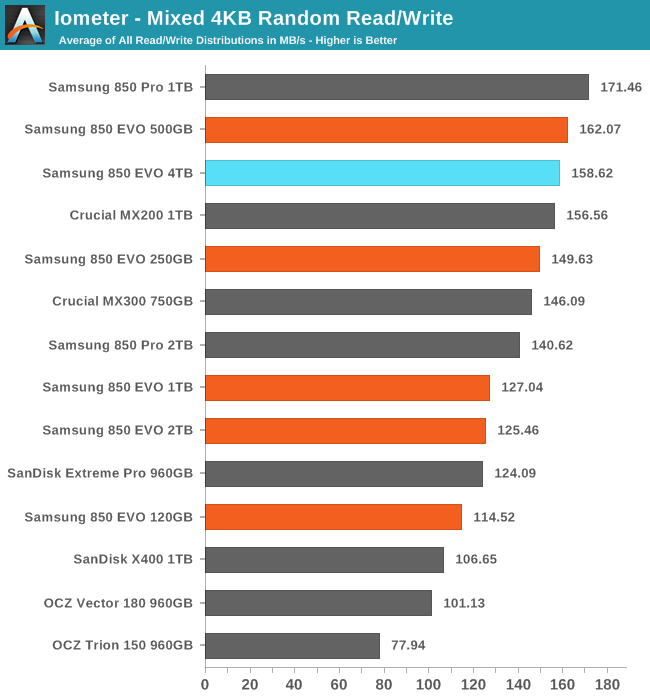
The mixed random I/O performance of the 4TB 850 EVO is much better than the other large 850 EVOs, putting te 4TB model close to the top of the chart.
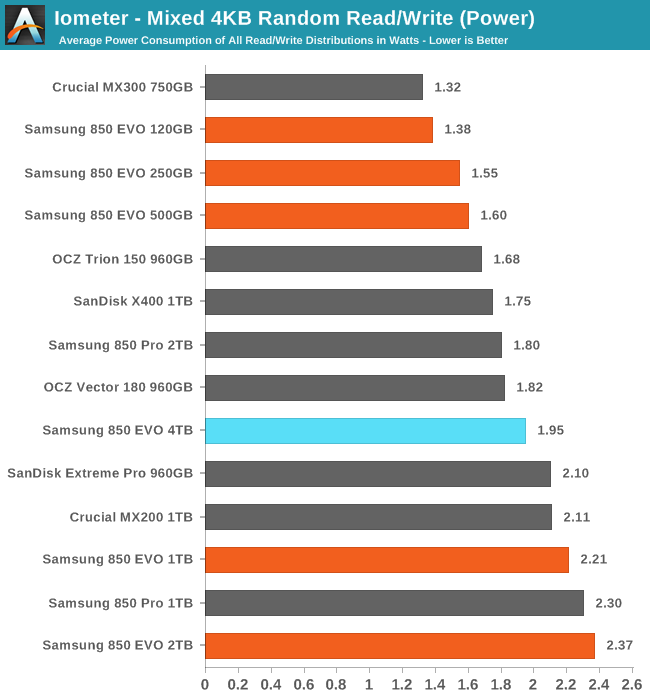
The 4TB 850 EVO also manages a large reduction in power usage as compared with the 1TB and 2TB 850 EVOs, making the 4TB much more efficient.
 |
|||||||||
Unlike the other 850 EVOs, the 4TB never loses performance as the proportion of writes in the test workload increases. Meanwhile, the power draw is essentially constant until near the end of the test.
Mixed Sequential Read/Write Performance
The mixed sequential access test covers the entire span of the drive and uses a queue depth of one. It starts with a pure read test and gradually increases the proportion of writes, finishing with pure writes. Each subtest lasts for 3 minutes, for a total test duration of 18 minutes. The drive is filled before the test starts.
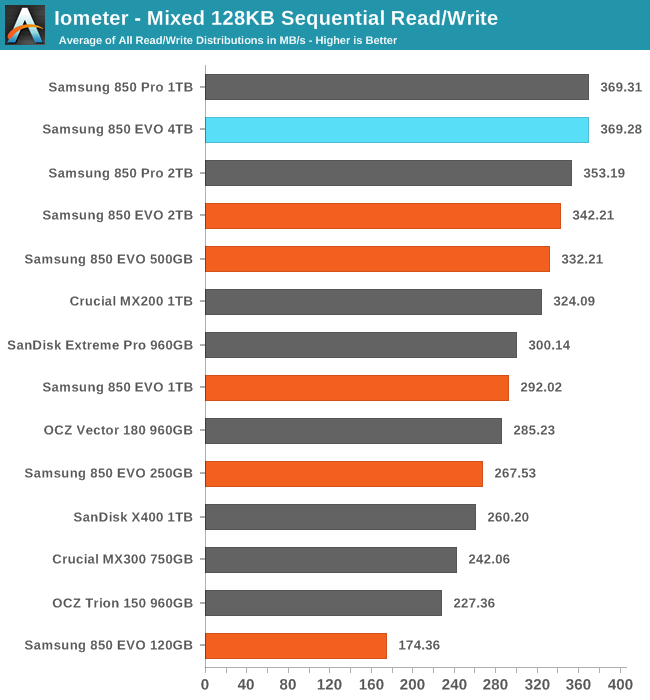
The 4TB 850 EVO is essentially tied for the best mixed sequential read and write performance.
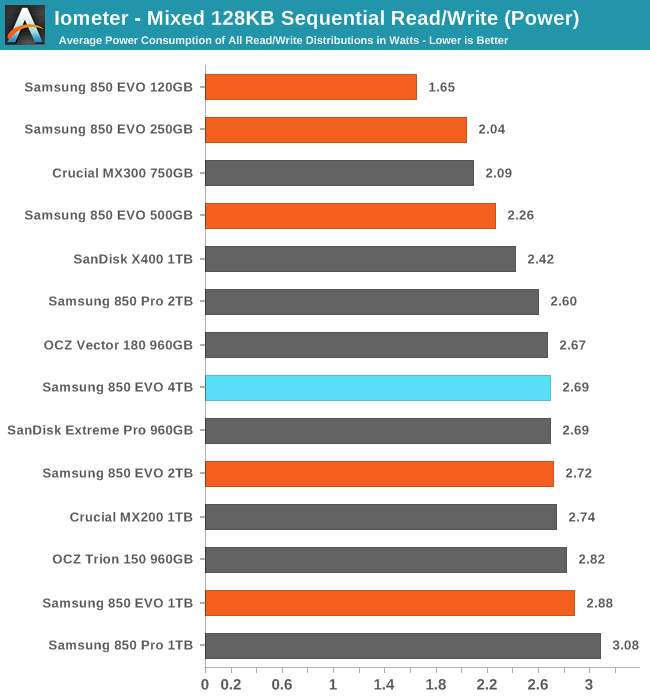
The 4TB 850 EVO averages using slightly less power than the 2TB model, and it is one of the most efficient of the large drives.
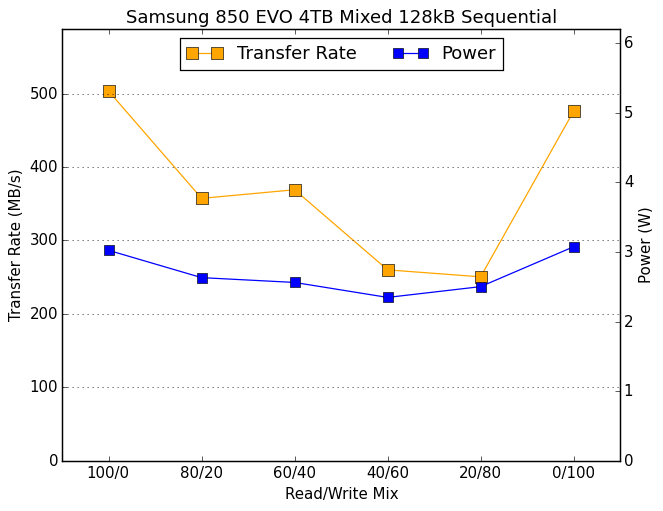 |
|||||||||
The usual pattern is for performance on this test to resemble a bathtub curve, but the 2TB 850s and the 4TB 850 EVO don't lose as much of their performance during the first half of the test, leading them to bottom out much later than most other drives.










145 Comments
View All Comments
JellyRoll - Monday, July 11, 2016 - link
It is relative. 75 total drive writes of 4TB are huge.Daniel Egger - Monday, July 11, 2016 - link
Not at all. There're many scenarios where one would chose a larger drive without immediate need. In fact I'd never take a drive I can immediately fill up a 100%, what'd be the point in that? Also this is a consumer drive and how many customers do you know *writing* away TB after TB, many kinds of data are actually write-once-read-often...My laptop SSD has been powered on for pretty much exactly two years now and seen 10TB writes per year. My home VM server sees 9.2 TB writes per year. So pretty much harmless and those two cases are already very much non-consumer scenarios...
ddriver - Monday, July 11, 2016 - link
If you really do a lot of writing, say you work with RAW 4k video, then you really don't care that much about latency, all you care about is bandwidth and capacity. In this case, what you really need is a good RAID controller and a dozen of good old HDDs.vladx - Monday, July 11, 2016 - link
This drive is not suited for 4K video work, everyone knows that. Using an EVO for that kind of work iwould be very irresponsible and failure is 100% in the hands of the user .Oxford Guy - Monday, July 11, 2016 - link
I'll agree with you if there is a big red sticker on the box that says that.vladx - Tuesday, July 12, 2016 - link
@Oxford Guy: And this why we get people ranting about SSDs when it's their own fault for being ignorant.Kevin G - Monday, July 11, 2016 - link
Indeed and at this point you'd want a fast NVMe drive for high quality 4k captures.A 4 TB SATA SSD does have utility as a means to provide storage for an assort of cameras and equipment build around SATA drives. There are a lot of those out there mainly because U.2 hasn't taken hold (yet?).
ddriver - Monday, July 11, 2016 - link
Who captures video to PC LOL. Who logs a computer along with a camera.Impulses - Monday, July 11, 2016 - link
Some high end cine cameras actually capture straight to SSDImpulses - Monday, July 11, 2016 - link
Pretty sure he meant it as in 'working with 4K' anyway.